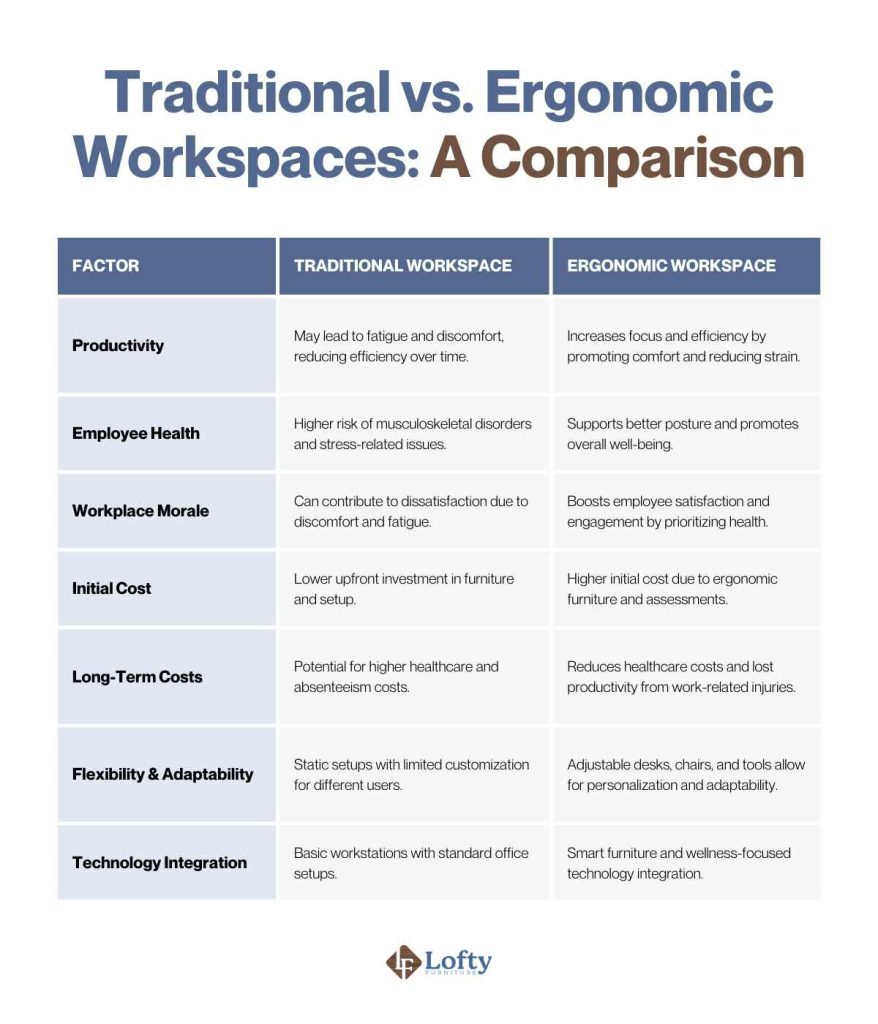As the way we work continues to evolve, ergonomics is emerging as a key driver in shaping the future of workspaces. With the rise of remote and hybrid work models, organizations and individuals are prioritizing comfort and well-being like never before. In 2025, workplace design will go beyond aesthetics, focusing on creating environments that support physical health and enhance efficiency.
Key Takeaways
- In 2025, workspaces will focus on improving comfort and productivity through ergonomic and flexible setups.
- AI, smart furniture, VR/AR, and nature-inspired designs will enhance comfort, health, and efficiency.
- Offices will offer adjustable furniture and customizable designs to meet individual needs and work styles.
This article explores the latest trends, innovations, and strategies that will shape ergonomic workspaces in 2025 and beyond.
The Current State of Workspaces
Work has changed a lot recently, especially with more people working from home or splitting time between home and the office. Over half of the workforce in many places is now working remotely or in a hybrid setup, so we need to rethink how we create our workspaces to make them flexible and suited to each person’s needs.
Even before this shift, regular offices had their issues. Many people struggled with back pain from sitting too long or eye strain from staring at screens, not to mention feeling mentally drained in poorly designed spaces. These aren’t just minor problems—they can cost companies big time, affecting productivity, increasing healthcare costs, and leading to higher employee turnover. Now more than ever, we need better, personalized solutions to keep up with the changing way we work.

Key Ergonomic Technologies Shaping Workspaces in 2025
By 2025, we’ll see a surge in smart solutions that personalize and optimize our work environments. Here are some of the key technologies driving this change:
1. AI-Powered Ergonomic Monitoring and Adjustment
Artificial intelligence and sensor technology will become integral, monitoring posture, movement, and even environmental factors like lighting and temperature in real-time. This data will power features like automatic desk and chair adjustments, personalized real-time feedback delivered through apps or haptic devices.
Paul Sher, founder of FuseBase, a B2B SaaS platform focused on workflow automation and digital workspace optimization, predicts:
“We foresee desks evolving to adjust their height and angle based on real-time data collected from users, and this will allow individuals to work more comfortably over longer periods. Our team at FuseBase believes that AI-assisted navigation will optimize workspace layouts, enhancing efficiency while promoting both health and productivity.”
2. Advanced Ergonomic Furniture and Workstations
The future of ergonomic furniture is all about more than just basic adjustments. Expect ergonomic chairs that adjust to fix poor posture, desks that move throughout the day to keep you active, and workstations that can be reconfigured for different tasks. We’ll also see smart fabrics that give feedback, sensors that track your health, and materials that adjust to your body temperature. Personalization will be huge, with furniture that learns your preferences and adapts on its own.
Here’s a table showcasing different types of advanced ergonomic furniture, along with their key features and benefits:

Experience the future of comfort: Upgrade to modern ergonomic chairs and discover how advanced ergonomic technology can transform your posture and productivity today.
3. Virtual and Augmented Reality (VR/AR) for Ergonomic Design
VR and AR will revolutionize ergonomic training and workspace design. By simulating realistic work environments, VR can provide immersive training modules that teach proper posture and movement. It also has training effectiveness advantages, which is reflected in less task time, errors, and cognitive load. AR can overlay real-time feedback onto a user’s view, guiding them towards optimal ergonomic practices.
Rich Edwards, CEO of Vibra Media, a company focused on marketing and technology solutions, shares:
“Technologies like VR and AR make it easier to personalize each employee’s environment, enhancing efficiency and well-being while offering exciting new ways to engage with routine tasks.”
4. Biophilic Design and Ergonomics

Features like natural lighting and integrated greenery will not only enhance aesthetics but also improve employee well-being. Study conducted by the Human Spaces research group revealed that employees in workplaces with strong biophilic features reported lower levels of stress and anxiety.
As Daniel Trotter, co-founder of PPC Geeks, adds:
“Technology will play a crucial role in evolving workspaces but we should also include elements that focus on mental health to create spaces that prioritize well-being. The push for holistic design calls for the inclusion of natural elements, like plants and natural light, as these changes can lead to a healthier, more positive environment.”
5. Flexible and Adaptive Workspace Designs
The trend towards flexible and adaptive workspaces will continue, with a focus on modular designs that can be easily reconfigured to meet individual ergonomic needs. Justin Mauldin, founder of Salient PR, shares:
“By leveraging advancements such as interactive seating and adaptive lighting, we help organizations create a comfortable and efficient work environment. As workspaces evolve, the importance of tech integration increases because it allows for flexibility and accommodates diverse work styles.”
Benefits of Ergonomic Technology in the Workplace
The integration of advanced ergonomic technology into workspaces offers a multitude of benefits. Studies consistently demonstrate a significant reduction in musculoskeletal issues and stress levels among workers who utilize ergonomic solutions. When employees are comfortable and supported, they can focus more effectively on their tasks. Studies have shown a direct correlation between ergonomic adjustments and improved performance, with some reports indicating a productivity boost.
Beyond individual well-being and productivity, ergonomic technology also presents substantial cost savings for organizations. By proactively addressing potential health effects, companies can significantly reduce healthcare expenses associated with workplace injuries and illnesses. Furthermore, a decrease in absenteeism due to discomfort or pain contributes to a more consistent and productive work environment.

Implementing Ergonomic Technology: Best Practices
To effectively integrate ergonomic technology, start by assessing the specific needs of your workforce based on their job roles and health concerns. Personalize the solutions by offering adjustable and customizable options that cater to individual differences. Make sure the technology integrates smoothly with existing systems and is user-friendly. It’s also important to foster awareness by educating employees about ergonomics and encouraging regular movement throughout the day. Invest in high-quality, durable products that offer long-term value, and regularly monitor their effectiveness, staying up-to-date with the latest ergonomic innovations.
The Future Outlook: Ergonomics Beyond 2025
Looking beyond 2025, the evolution of ergonomics will continue to be driven by technological advancements and a growing emphasis on holistic well-being. We can anticipate even greater integration of Artificial intelligence and personalized data to create truly adaptive and responsive workspaces. Ergonomics will extend beyond physical comfort to encompass mental and emotional well-being. The concept of a “living workspace” will emerge, where environments dynamically adjust to the individual’s needs, promoting optimal health and productivity.
FAQs
How will AI-driven ergonomics personalize my workspace?
AI-driven systems will use sensors to monitor your posture, movement, and environmental factors in real-time. This data will be used to automatically adjust your desk, chair, lighting, and temperature to your specific needs.
What are the long-term benefits of investing in ergonomic technology?
Investing in ergonomic technology can lead to reduced musculoskeletal issues, decreased stress levels, increased productivity, and significant cost savings through lower healthcare expenses and reduced absenteeism.
How can small businesses implement effective ergonomic solutions?
Small businesses can start by conducting a needs assessment, prioritizing adjustable furniture and equipment, and providing employee training on proper ergonomic practices.

Great insights on ergonomic technology! This blog perfectly blends comfort with innovation to support healthier workspaces. Truly informative and useful!